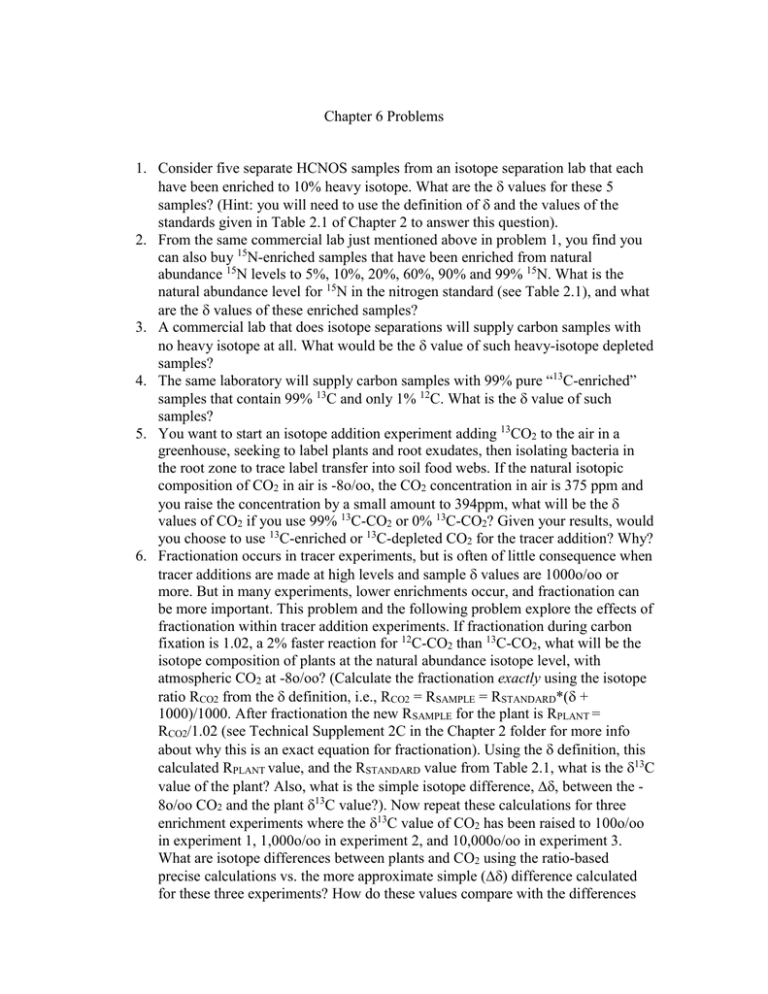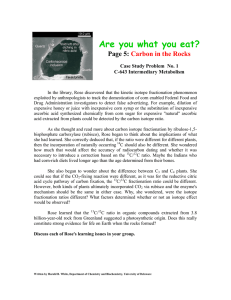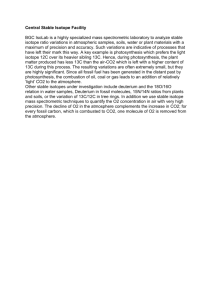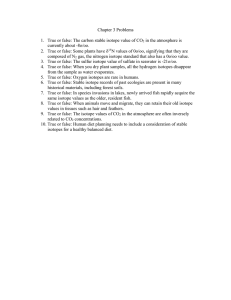Chapter 6 Problems.doc
advertisement

Chapter 6 Problems 1. Consider five separate HCNOS samples from an isotope separation lab that each have been enriched to 10% heavy isotope. What are the values for these 5 samples? (Hint: you will need to use the definition of and the values of the standards given in Table 2.1 of Chapter 2 to answer this question). 2. From the same commercial lab just mentioned above in problem 1, you find you can also buy 15N-enriched samples that have been enriched from natural abundance 15N levels to 5%, 10%, 20%, 60%, 90% and 99% 15N. What is the natural abundance level for 15N in the nitrogen standard (see Table 2.1), and what are the values of these enriched samples? 3. A commercial lab that does isotope separations will supply carbon samples with no heavy isotope at all. What would be the value of such heavy-isotope depleted samples? 4. The same laboratory will supply carbon samples with 99% pure “13C-enriched” samples that contain 99% 13C and only 1% 12C. What is the value of such samples? 5. You want to start an isotope addition experiment adding 13CO2 to the air in a greenhouse, seeking to label plants and root exudates, then isolating bacteria in the root zone to trace label transfer into soil food webs. If the natural isotopic composition of CO2 in air is -8o/oo, the CO2 concentration in air is 375 ppm and you raise the concentration by a small amount to 394ppm, what will be the values of CO2 if you use 99% 13C-CO2 or 0% 13C-CO2? Given your results, would you choose to use 13C-enriched or 13C-depleted CO2 for the tracer addition? Why? 6. Fractionation occurs in tracer experiments, but is often of little consequence when tracer additions are made at high levels and sample values are 1000o/oo or more. But in many experiments, lower enrichments occur, and fractionation can be more important. This problem and the following problem explore the effects of fractionation within tracer addition experiments. If fractionation during carbon fixation is 1.02, a 2% faster reaction for 12C-CO2 than 13C-CO2, what will be the isotope composition of plants at the natural abundance isotope level, with atmospheric CO2 at -8o/oo? (Calculate the fractionation exactly using the isotope ratio RCO2 from the definition, i.e., RCO2 = RSAMPLE = RSTANDARD*(+ 1000)/1000. After fractionation the new RSAMPLE for the plant is RPLANT = RCO2/1.02 (see Technical Supplement 2C in the Chapter 2 folder for more info about why this is an exact equation for fractionation). Using the definition, this calculated RPLANT value, and the RSTANDARD value from Table 2.1, what is the 13C value of the plant? Also, what is the simple isotope difference, between the 8o/oo CO and the plant 13C value?). Now repeat these calculations for three enrichment experiments where the 13C value of CO2 has been raised to 100o/oo in experiment 1, 1,000o/oo in experiment 2, and 10,000o/oo in experiment 3. What are isotope differences between plants and CO2 using the ratio-based precise calculations vs. the more approximate simple ( difference calculated for these three experiments? How do these values compare with the differences calculated for the first natural abundance experiment? Does fractionation seemingly grow, shrink or stay the same in the enrichment experiments? Why? Looking at your combined results, do you agree with the first sentence of this problem? Why? 7. Repeat problem 6, but instead of using 13C-enriched CO2, use 13C-depleted CO2, so that the three tracer experiments have CO2 whose 13C value has been lowered to -100, -500, and -950o/oo. Assume again that fractionation during carbon fixation is 1.02, a 2% faster reaction for 12C-CO2 than 13C-CO2, and calculate the exact isotope composition of plants growing with the -100, -500, and -950o/oo CO2. Does fractionation seemingly grow, shrink or stay the same in these “12C enrichment” experiments that are also “13C-depletion” experiments? Why? Overall, considering results of your calculations for problems 2, 6 and 7, is there a value for enrichment experiments above which you don’t have to worry about fractionation? 8. You are working with a stream ecosystem, and decide to perform a tracer addition experiment over 6 weeks during a summer field season. The stream has a very low natural ammonium concentration of 0.1 mmol m-3 and flows downhill rapidly at a rate of 5 m3/sec. To bring the ammonium isotope value to 1000o/oo, how many grams of 15N isotope do you have to add during the 6 weeks (42 days), assuming that the background ammonium has the same value as the atmospheric air standard (see Table 2.1 in Chapter 2) and that you use 10% 15N-labeled ammonium that also contains 90% 14N? If the 10% 15N-labeled ammonium is commercially available as ammonium sulfate at $220 for 50g, how much will you have to spend for the summer experiment? If the calculated amount is too expensive, what could you do to lessen costs but still have an effective labeladdition experiment with added 15N-labeled ammonium? (Hint: you may want to consult Technical Supplement 6A on this CD for strategies about calculating isotope amounts added to field experiments). 9. What are the HAP (atom percent heavy isotope values) values for samples with values of -30o/oo for each of the HCNOS elements? What are the atom percent values for samples with values of 1000o/oo for each of the HCNOS elements? (Table 2.1 and Conversion 4 in the printed Appendix to the book can be helpful for this problem). For the enriched +1000o/oo values, what are the “atom % excess” values after subtracting the natural background atom percent values of the standards in Table 2.1? 10. You make a 1:1 mixture of two samples that have equal carbon concentrations, and values of -20 and -40o/oo. Calculate the atom percent values for 13C content for the -20 and -40o/oo values, give the atom percent value for the mixture, then use that value to calculate the true 13C value of the mixture. How different is this value that simply averaging the -20 and -40/oo values? Repeat this experiment with values of -20 and +100o/oo, -20 and +1000o/oo, and -20 and +10,000o/oo. Given your results, when do you think using values is acceptable for calculating mixing dynamics, and when do you think you need to use atom % values?





